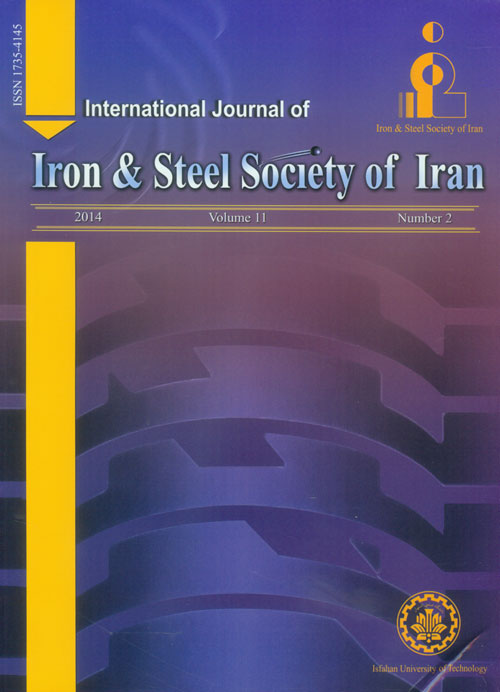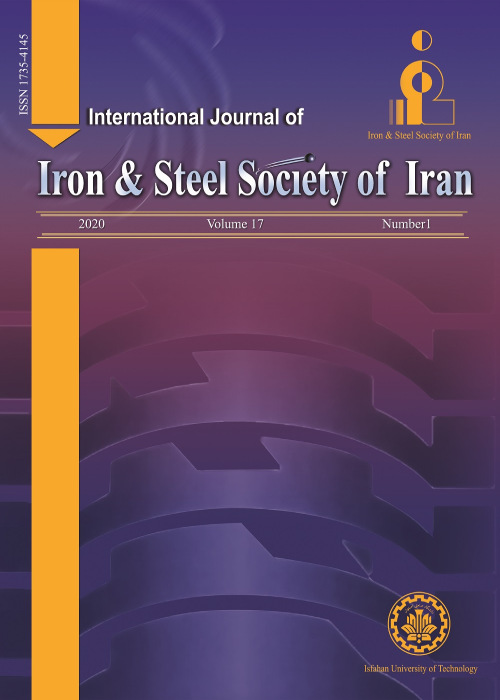فهرست مطالب

International Journal of iron and steel society of Iran
Volume:11 Issue: 2, Winter and Spring 2015
- 40 صفحه،
- تاریخ انتشار: 1394/04/01
- تعداد عناوین: 7
-
-
Pages 1-5In the present study, the effect of grain size on the austenite stability was studied by nanoindentation tests in a 304L stainless steel. Thermomechanical processing based on cold rolling and annealing was used to produce two different types of austenite: ultrafine grained (UFG) austenite with the average grain size of 0.65 μm and coarse grained (CG) austenite with the average grain size of 12 μm. Scanning Electron Microscope (SEM) and Transmission Electron Microscope (TEM) were used to follow the microstructural changes during rolling and annealing. The results of nanoindentation tests showed popin in the load-displacement curve of the CG sample while no observable pop-in was found in the UFG sample. after the occurrence of each pop-in event in the CG sample. This behavior was related to the change of plastic deformation mode due to the martensitic transformation. The present results, therefore, confirmed that the UFG austenite had higher stability to withstand martensitic transformation.Keywords: Nanoindentation, Martensitic transformation, Austenitic stainless steel, Pop, in
-
Pages 6-10In the present study, the microstructure and mechanical properties of the dissimilar welding between ASTM A335 low alloy steel and ER309L austenitic stainless steel were investigated using the gas tungsten arc welding process. The welding of dissimilar materials between ASTM A335 low alloy steel and ER309L austenitic stainless steel was found to have a significant effect on the microstructure when the filler metal of ER309L was used. This research also studied the effect of carbon migration from the heat-affected zone (HAZ) to the melted zone in the interface between A335 low alloy steel and 309L filler metal using microstructure analysis and Scanning electron microscopy-energy dispersive spectroscopy (SEM-EDS) Line Scan Technique. The results showed that the solidification of 309L as a primary ferrite exhibited a skeletal ferrite morphology and the solidification of ferritic-austenitic (FA) type. Moreover, the results of EDS provided evidence showing carbon migration from the low chromium side to the weld metal which had a higher chromium content and a tiny martensitic zone occurred in the melt boundary with a high hardness value. In the tensile test, all specimens were broken in the HAZ of A335 low alloy base metal with a ductile fracture and the welded specimens also showed the ductile fracture in the impact test.Keywords: Low alloy steel, Carbon migration, Microstructure, mechanical properties
-
Pages 11-16The effect of ferrite grain size on the fatigue and tensile properties of dual phase steels with a 0.25 volume fraction of martensite (Vm) under different heat treatments was investigated. The heat treatments were homogenized at 1200 oC along with several subsequent normalizations at 910 oC, resulting in different microstructures and mechanical properties. After heat treatment, the obtained steels, with different ferrite grain sizes, were heat treated to obtain a dual phase ferritic-martensitic microstructure. In order to process the dual phase steels, low carbon manganese steel was used. Fatigue tests were carried out at room temperature and the fracture surfaces of the fatigue specimens were studied by SEM. The data obtained by the fatigue tests indicated that the fatigue strength at 107 cycles had a linear increase with decreasing the grain size of ferrite, while higher applied stress had a little effect on the grain size and the fatigue strength. The fracture surface of the fatigue specimens showed two distinct regions, namely, the fatigue fracture and the final fracture. Striation lines were clearly seen in the region of the fatigue failure. Furthermore, for all microstructures, the final fracture was mainly brittle.Keywords: Dual phase steels, Fatigue, Ferrite, martensite, Grain size, Heat treatment
-
Pages 17-22In this work, the effect of erosion on corrosion behavior of coal tar epoxy coating was evaluated using electrochemical impedance spectroscopy (EIS) measurements. The surface morphology of the coating was examined by scanning electron microscope (SEM) after 10, 20, 30, 45 and 60 min of erosion process at an impact angle of 90º. After 10 min of erosion process, the Nyquist plots showed just a single large capacitive semicircle and the phase Bode plots exhibited a line close to −80o in the middle-frequency region, thereby indicating high corrosion resistance (about 109 Ωcm2). After 20 and 30 min of erosion process, the diameter of the Nyquist semicircle was decreased with time and two semicircles appeared after 45 min. Furthermore, SEM observations revealed that the protection performance of coating was decreased by an increase in time of erosion due to the formation of holes and electrolyte penetration into the coating. Finally, after 60 min of erosion process, the coating was partially removed and the substrate appeared.Keywords: Erosion, Electrochemistry, Coal tar coatings, Surface morphology, EIS
-
Pages 23-27Nowadays, magnesia carbon refractories are very important for the iron and steel industries. It is due to their unique properties, such as low wet ability with melt iron and steel. Therefore, it is important to extend the life of the refractory. In this research, the effect of calcined alumina and nano carbon on mechanical strength and corrosion resistance against slag in magnesia carbon refractories was studied. Mechanical strength of cold crushing strength, CCS, was measured. The bulk density, BD, and apparent porosity, AP, were determined, relative to the size and weight measured, using Archimedes method standard and corrosion resistance against the slag shrub procedure. Cylindrical 50×50 mm samples were tempered at 250 oC for 3 h. The corrosion resistance of the samples cocked at 1350 oC for 2 h under reducing atmosphere (coke bed) was evaluated. XRD and SEM-EDS analyses were used for characterizations. The results showed that the combination of calcined alumina, magnesia, graphite and nano carbon produced very high strength up to 50% and density up to 12.5%, as well as very good corrosion resistance. Especially, the samples containing alumina showed better corrosion resistance, as compared with other samples, due to spinel phase.Keywords: MgO, C refractory, Alumina calcined, Nano carbon, mechanical properties, Corrosion resistance against slag
-
Pages 28-33Two different dual phase steels were prepared from low carbon manganese steel after the elimination of the banding using the direct quenching (DQ) and the step quenching (SQ) procedures. Different heat treatments resulted in different martensite morphologies, microstructures and mechanical properties. The heat treatments were designed in such a way to obtain a 0.25 volume fraction of martensite (Vm). For this reason, an intercritical temperature of 725 oC was applied. Furthermore, the tensile and impact properties were discussed. The results from the impact and tensile tests at different temperatures showed that the ductile-brittle transition temperatures for the DQ and SQ treatments were -49 and -6 oC respectively, while the DQ had better toughness.Keywords: Dual phase steels, Fixed volume fraction of martensite, Impact properties, Toughness
-
Detailed Microstructural Evolutions of TWIP Steel During Tensile Straining: In situ SEM ObservationsPages 34-36Microstructural evolutions of twinning induced plasticity (TWIP) steel during tensile straining wereinvestigated by in situ SEM observations. The results indicated that slip lines and mechanical twins as well as surface relief were increased with increasing strain, resulting in a stepped surface. Additionally, these deformation mechanisms could change the shape of each grain via shear and rotation. Nonuniformly distributed strain within grains led to change in the misorientation or banding of deformation markings with further straining.Keywords: TWIP steel, Slip, Mechanical twinning, Surface relief


